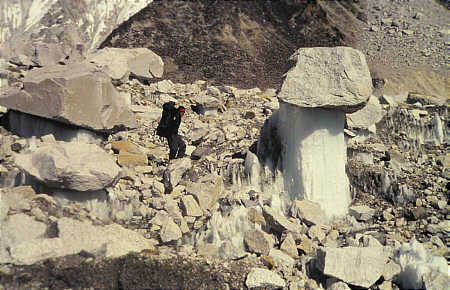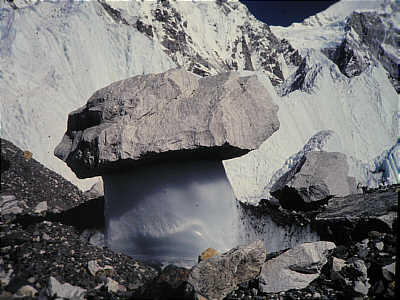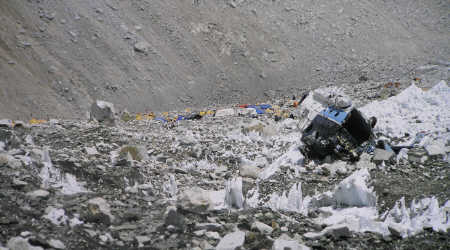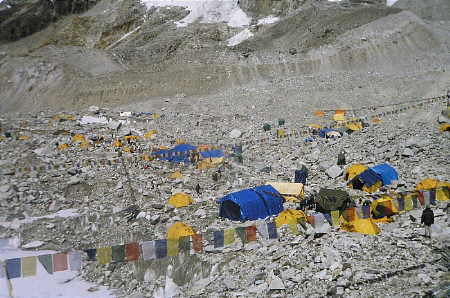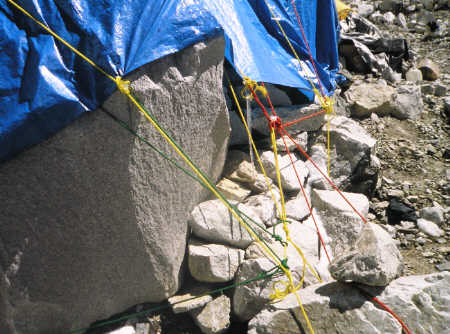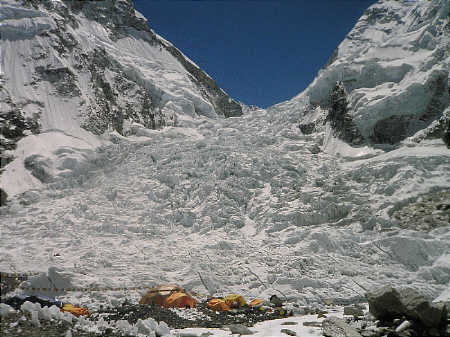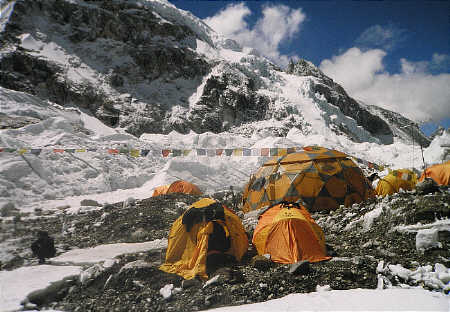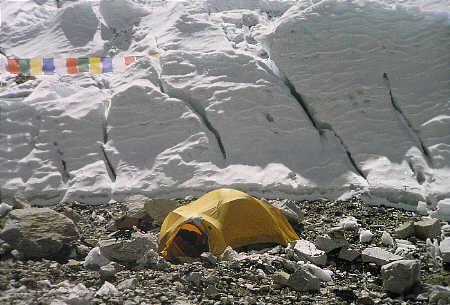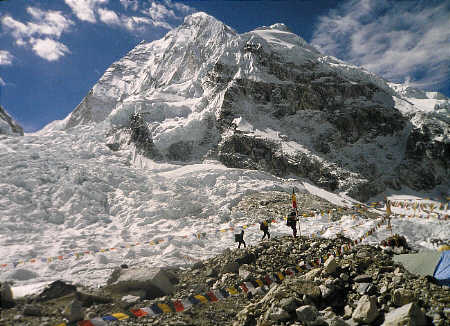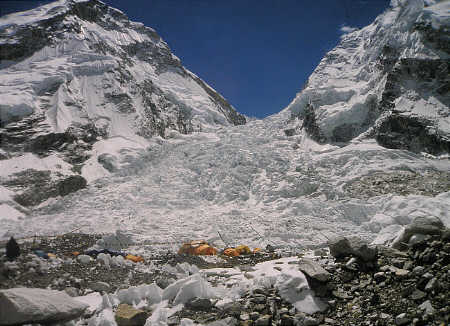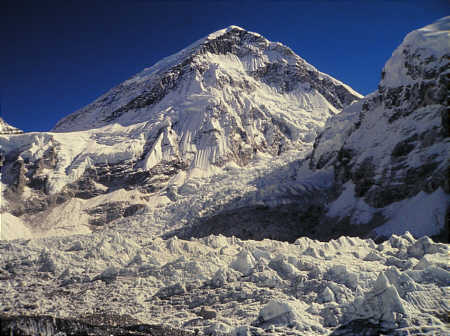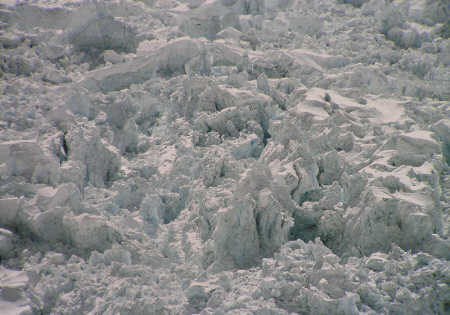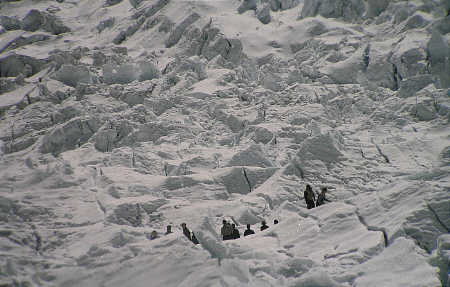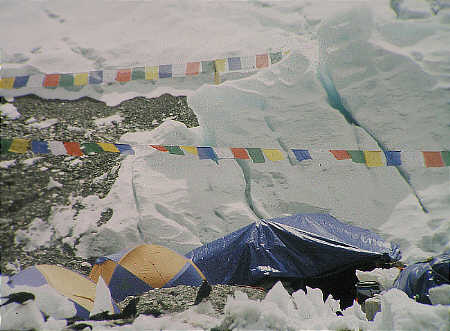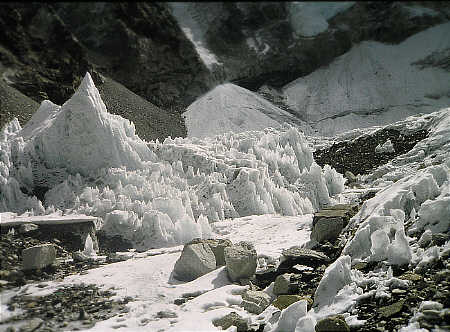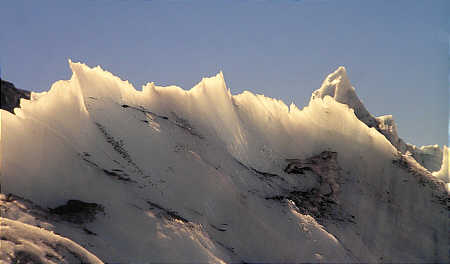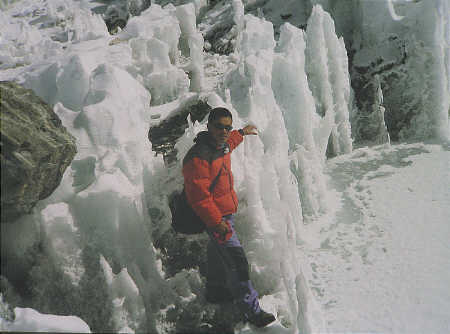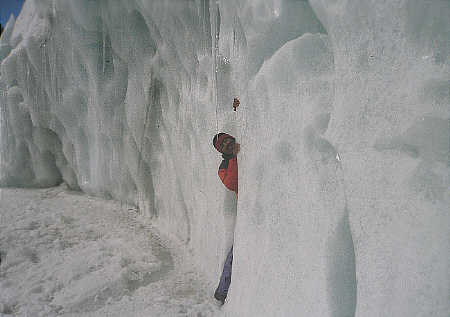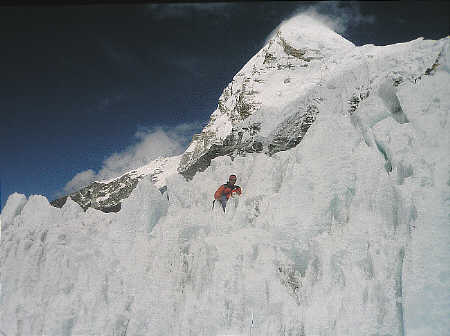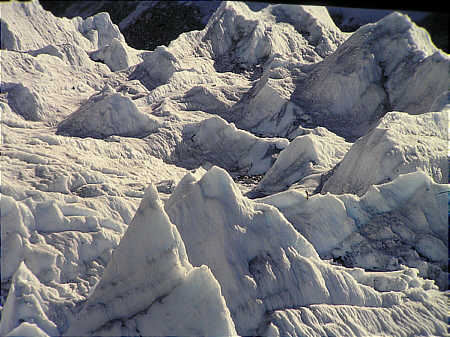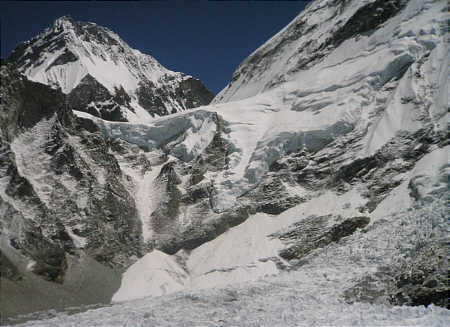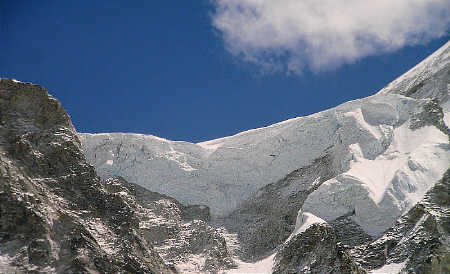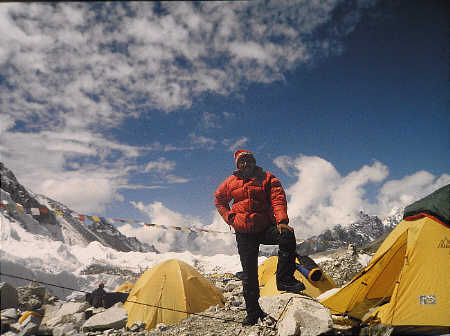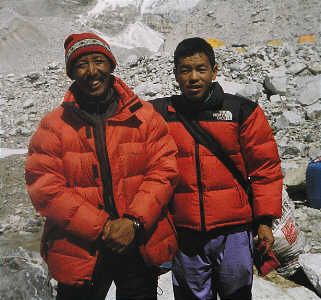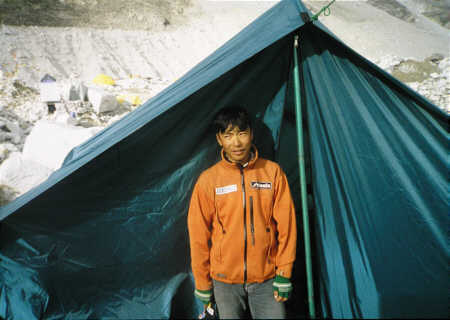|
|
|
Summary: Trekking in Nepal- on this page you will find a description of the trek from Gorakshep to the Everest base Camp with many pictures Trekking from Gorakshep to the Everest Base Camp EBC at 5350 m So near to Mt. Everest – Sagarmatha - Chomolongma
I already have been to EBC three time and have enjoyed it every time. For me it is a bit sad that many people, even if they are staying as far as in Gorakshep, don’t go there. I have heard several
times that people think that the trek is not really worth the effort, and that EBC is a big garbage dump, which is definitively nonsense. Expedition time: Fall/winter: In November you probably will not find any Expeditions at EBC. It is just too cold, and more importantly, in the fall and winter seasons the jet-stream comes down south blowing at more than 200 km/h on the high 8000m-mountains. On the other hand, the weather will be more stable and you will have a good chance to get some beautiful views. You need about 2.5-3.5 hours to go from Gorakshep to EBC. Allow yourself at least 2 hours additional time, as the real fun is climbing and playing between the marvellous ice-seracs of the lower Khumbu ice fall. People who just go up there just have a look from a viewpoint and then return definitively miss a lot. For me it doesn’t make any sense to climb Kala Patar in the morning and continue to on to EBC in the same day. Take a whole day, it is absolutely worth it to take your time and enjoy the trip.
Picture 1: A group of trekkers leave Gorakshep for EBC
Picture 2: The trail is on the northern moraine of the Khumbu glacier and in April many goods are transported by yaks.
Picture3: Above 5000m makes trekking pretty tiring and so a break is very welcome. In the background one can see the Tibetan Changtse.
Picture 4: From the moraine you have a wonderful view of the glacier below.
Picture 5: After a step descent, you will walk to the glacier. The Khumbu glacier moves very quickly and every day new crevasses open. Therefore, the trail is permanently changing.
Picture 6: On the way you will pass many enormous glacial tables
Picture 7: Big rocks are protecting the ice from the sun, so that the ice does not melt here. In this picture you can see how much ice has already been melted on the rest of the glacier.
Picture 8
Picture 9: In 2003 a helicopter crashed just near EBC and two people died. Although a helicopter can fly above 6500 m, landing is very dangerous at 5500 m and not possible at higher elevations.
Picture 10: The various expedition groups are scattered all around the Base Camp site. They always have a big common tent, a kitchen tent and many little individual tents.
Picture 11: The tents are put up on the glacial ice. As it is very difficult to affix tent pegs in this brittle ice, so you have to attach them to big stones and rocks
Picture 12: The Khumbu icefall spills over from the upper western Cwm and plunges nearly vertical around 700 m down.
Picture 13: The Korean Camp site.
Picture 14: How about some ice for your soda?
The toilets During the main expedition season it is not unusual to have around 300-500 persons living at EBC. Therefore, hygiene is pretty important. It would be an ecological disaster if everyone just shit behind some rocks. Even more important, this would surely lead to severe epidemics of diarrhoea, crushing the dreams of many people on their once-in-a-lifetime climb of Mt. Everest. For this reason every expedition team must provide proper toilets. In fact, the toilet is just a standard plastic drum, with two little planks above it, and then you have the little toilet-tent. The drums are brought regularly to Gorakshep where the smelly content is buried so it can rot during the warm summer months. Expeditions calculate that one toilet costs about 400 USD per season! If you ever go there with you own tent, definitely ask before you use any of the toilet tents. Otherwise they could heavily charge you.
Picture 15: The camp of the Canadian /Quebec Expedition. You see the three little black tents. Left the shower tent and right the two little toilet tents.
Picture 16: A typical EBC-shithouse. I was camping about 50 m from the Canadians and the allowed me kindly to use it. ”Merci les Quebequois!”
Picture 17: My little tent was set on solid ice but during the night the glacier made a lot of strange sounds. My friend and porter-guide Bachan had some very bad nightmares, dreaming that a big crevasse would open and devour us.
Picture 18: Sherpas on the EBC
Picture 19: Khumbu Icefall with the Korean Camp
Picture 20: After descending, the glacier turns in a sharp bend to the south. But even in the flatter part you will find many high seracs and ice-pyramids.
Picture 21: Enormous ice blocks come down in a formidable entanglement
Picture 22: My first trip to EBC in November 1992
Picture 23: You can imagine that finding a trail through this chaos is difficult. Crossing the Khumbu Icefall is still one of the most dangerous part of an Everest expedition. Normally a Sherpa group or one or two expeditions have the task of making the trail and conserving it. Many crevasses are so large, that one has to use long aluminium ladders. As the glacier is permanently moving, the trail also has to be changed and secured throughout the season. In 2004 I returned in November, and none of the trails from the spring were there anymore.
Picture 24: A group of Sherpas begin their ascent in the Khumbu Icefall
Picture 25: A yak bringing new goods
Picture 26: Every Camp has many prayer flags
Picture 27: The ice is never far away
Picture 28: To really enjoy EBC you have to go right to the beginning of Khumbu Ice fall
Picture 29: A fairy Ice landscape
Picture 30 Ice sculpture
Picture 31: All the expeditions agree on a place to get clear water. Then everyone takes care, so that the surroundings are not spoiled.
Picture 32: For many hours my friend Bachan and I were frolicking in this marvellous ice-landscape, climbing some seracs and admiring the breathtaking sculptures nature had carved our of the ice.
Picture 33
Picture 34
Picture 35
Picture 36: Also in 1992 my porter-guide Pemba is enjoying himself, pretending to be a summiter.
Picture 37
Picture 38
Picture 39: The 6006 m high Lho la pass leads to Tibet, but it is very difficult to cross. In the background you see Changtse
Picture 40: The huge glacier over the Lho La pass. World record holders It is amazing, but there so many Sherpas who have been on top of Everest that you are sure to meet several of them. Many of them have invested their wages in their own lodges. During my trek in spring 2004 I met two exceptional men, APA Sherpa and Pemba Dorje Sherpa, both record holders. Apa Sherpa. My first encounter with him was on EBC when I was looking for Pemba Sherpa. I saw tents of the Nepalese trekking and expedition agency for which he was working and asked for him. Apa
Sherpa shooed me away, saying that Pempa Dorje was not there. One has to know that most expeditions are very busy and concentrate very hard on their goal, so they don’t like too many
visitors. The next day I met a Belgian member of his team who invited me to tea. This day Apa was really nice. He successfully ascended Everest for the 14th Time in this season and is word record holder.
Picture 41: Apa Sherpa and the Belgian alpinist
Picture 42: Apa Sherpa - word record holder with 14th ascents of Everest.
Picture 43: Apa Sherpa and my friend Bachan Rai Pemba Dorje Sherpa On the way to Gorakshep I had met Pemba Dorje Sherpa and had a very nice chat with him. He was on the way to EBC to preparing for the arrival of his Swiss client. He also wanted to try a new world speed record: the goal was to climb Everest from EBC in less than 8.5 hours. He had been the record holder before, but three days later another Sherpa (and his biggest rival) was again faster. In spring 2004 he succeeded in climbing Mt. Everest in 8 hours and 10 minutes!
Picture 44: Pemba Dorje Sherpa fastest climber of Mt. Everest ever
Picture 45: The common Tent, see the luxury of a petroleum oven
Picture 46: Two Everest summiteers: Pemba Dorje Sherpa and the tenant of Snowland Inn lodge in Gorakshep I hoppe that theis pictures will help you to decide if you should go up to EBC itself and i wish you a wonderful trekking experience. I like also to thank Grandma B, well known from yetizone trekking board who helped me kindly to write the English text.
|
|||||||







